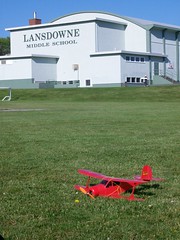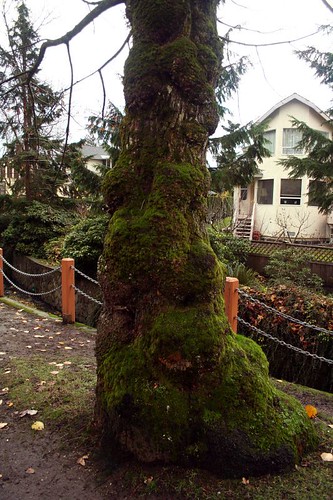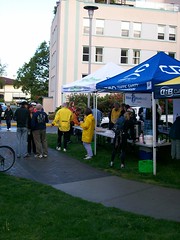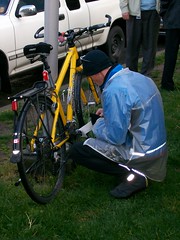Last night’s council meeting was an interesting one, not just because of the content but also because there were several split votes, a relative rarity in Oak Bay. There was also a whole variety of things covered, from the Bowker Creek watershed to variances and a shiny red firetruck. See the full agenda (PDF) for the whole list. Nils Jensen was missing tonight and having only 6 did lead to two split votes.
 First up was a presentation by Tanis Douglas, Bowker Creek Initative Coordinator, and Jody Watson, chair of the BCI, about the BCI’s activities in 2008 and proposed activities in 2009. Tanis gave the bulk of the presentation then Jody then finished with a few final points and a call for funding for 2010 through 2012. There was a lot of discussion about the BCI, but council ultimately approved in principle funding the BCI going into the future.. I will have a more detailed post later today about the BCI’s presentation to council but for now, you can read BCI’s 2008 Annual Report (PDF) or the minutes from 2007’s council meeting about the 2007 report.
First up was a presentation by Tanis Douglas, Bowker Creek Initative Coordinator, and Jody Watson, chair of the BCI, about the BCI’s activities in 2008 and proposed activities in 2009. Tanis gave the bulk of the presentation then Jody then finished with a few final points and a call for funding for 2010 through 2012. There was a lot of discussion about the BCI, but council ultimately approved in principle funding the BCI going into the future.. I will have a more detailed post later today about the BCI’s presentation to council but for now, you can read BCI’s 2008 Annual Report (PDF) or the minutes from 2007’s council meeting about the 2007 report.
The Fire Chief then presented his after-the-fact request for council to approve a funding request to the Union of BC Municipality’s Age-Friendly Communities Initiative. Part of the larger World Health Organization’s Age-Friendly Cities, this funding is provided by the provincial and federal governments and Oak Bay is asking for $10,000 to map concentrations of vulnerable people and their potential routes to emergency services. I hope they make as much of data available as possible, in the spirit of open government.
The usually boring variance section of the agenda was far from that tonight. One of the most controversial applications was for 2064 Penzance, seen on the map of the right. The new house there had a wall that was over the allowed height and a stop work order had to placed on the building for that and a few other issues. Neighbours of the house were uniformly against it, with several showing up to talk about how the builder had failed to do any community consultation and their fears that the building would be flipped. Apparently the owner or builder was in the audience, but chose not to speak. Ultimately council voted against the variance request 6 to 0.
Interestingly, Tara asked about and was told that due to the way the bylaws are written, the owner can take down the wall and put up a roof 1′ higher than the existing wall, a gaming of the bylaws as with the Panorama Rec. Centre’s new slide.
Also controversial was a parking variance request for 1 space instead of 2. The bylaw (PDF) requires:
Two (2) parking spaces per dwelling unit, one of which shall be within a building.
which is totally crazy. Parking is a generator of traffic and if anything the municipality should be trying to reduce the amount of parking, not expand it. Also, parking spaces are usually impermeable, so adding more paved land isn’t going in the right direction to Ian Graeme of the Friends of Bowker Creek Society’s goal of 10% permeability (average residential is about 40%-50%. I don’t know what the exact % is for Oak Bay).
The whole parking issue also was amusing for us policy geeks, as the motion to table the motion for variance to allow notice to be given was defeated. This is not the motion to approve the variance, merely the motion to let staff give notice to neighbours that the variance request has been filed in case they want to write and/or speak about it at the next council meeting. However, this left the request in limbo, until a consultation of the Community Charter revealed that the Mayor or any Councillor can request a revote on any motion at that meeting or the next one. No, that didn’t have to make sense. Just know that the inner workings of council are very strictly regulated by provincial law, primarily the Local Government Act and the Community Charter.This often ties council into doing this certain ways.
The third contentious issue that has come up a bunch is the Tree Protection Bylaw and how to amend it. The one debated today allowed the council to make a ruling that any tree could be removed if it caused hardship to the owner, something no other tree protection bylaw has. Braithwaite spoke forcefully for following what the Parks & Recreation Commission suggested to take notes over the course of a year or so and then do a single large amendment, rather than piecemeal edit it. Thankfully today’s motion was defeated, but it was an interesting matchup with Herbert, Ney and Causton for and Cassidy, Braithwaite and Copley against. Not your usual “party line” vote.
And in more interesting news, Oak Bay is a getting a shiny hybrid fire engine. It will likely be painted red. Oak Bay was also compared to Rio de Janeiro and New York tonight, in reference to the house on Penzance. This adds to the list of Oak Bay being compared to downtown Vancouver a few months back. Those who wish to attend council in the summer, it has a greatly reduced schedule with Committee of the Whole meetings on July 13th and August 10th and Council meetings on July 20th and August 17th.








